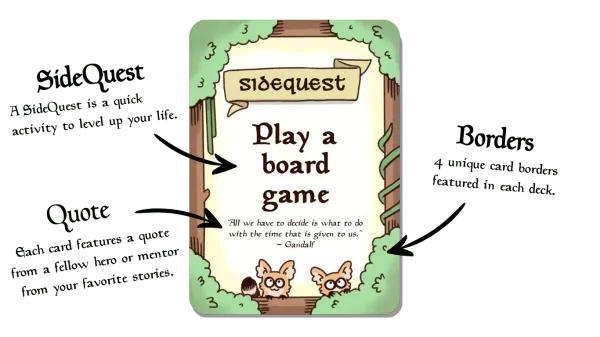№ 38 | A Friday Finds ✨Special Edition:✨ Solarpunk!

We interrupt our regularly scheduled broadcast…
The Friday Finds (implicitly ‘five’ Friday finds), are usually a collection of interesting things I’ve read, watched, or stumbled across over the past week. I’m going to do something different with this week’s Friday Finds, and focus on several recent finds that share a common theme: Solarpunk.
Personal Context
😬 Confession time: I struggle with what feels like an increasingly inevitable climate collapse. Add to this the conclusion that our current economic structures seem ill-suited to respond to this crisis, and… it’s easy to slip into despair.
This is stuff I usually keep to myself—the person I try be is everyday is positive and inspiring (Mr. Rogers is my personal hero, after all!). But, I struggle. I come across posts like this one. Every. Day.
It’s against this backdrop that I organized my 2020 Euro IA Keynote, “Hopeful and Powerless? Design in a Crisis.” It was a cathartic talk, created as much for myself as anyone else. And it’s one I often return to, if only to remind myself of healthy ways to think and behave in the midst of difficult situations. In spirit of sharing ‘things to think with,’ here’s the canvas from this talk (the fun, pirate-themed version of the canvas I created):

Anyway…
I’ve recently found a ray of hope in Solarpunk.
The Rise of Solarpunk Media.
I’m not sure when or how, exactly, but “Solarpunk” has been—increasingly—slipping into my various info-streams over the last half-year or so (maybe this was an adjacent leap from some of the Design, Architecture, and Gardening stuff I follow?! Who knows).
🤔 What is SolarPunk?
Short answer: It’s an environmental sci-fi genre. Though, it might be better understood as a reaction to the grimdark dystopian narrative that dominates so much of our media—books, movies, TV, episodes, video games, etc. Think BladeRunner, The Matrix, Akira, Altered Carbon, Neuromancer…
Behind the cyberpunk aesthetic of neon lights and leather clothes, we enter stories of high tech and corrupt mega corporations against which our protagonists must resist. Do a quick mental tally of just how many sci-if stories are set against a dystopian background (including those without the cyberpunk trappings), and you can see how this is the dominant narrative.
In contrast, Solarpunk is focused on how we might create more sustainable futures; the kinds of idyllic futures that I think many of us would prefer over that of the Cyberpunk / dystopian futures.
Here’s a more elaborate description:
Solarpunk identifies with a new ecologically positive, futuristic speculative movement that stresses a vision of a positive future with positive outcomes. This is a future that sits beyond scarcity and need. It is a visionary existence where hierarchy is shunned for a collective good. It is a future where our species is reintroduced to the natural world, while technology is remanded to purposes which further humankind’s needs on a whole, while continuing to remain ecologically green. Solarpunk breaks through the historical boundaries of science fiction and embraces the idea that “while the future might be an overwhelming prospect, it doesn’t have to be frightening, and it doesn’t have to hurt”.
[Source]
The Solarpunk aesthetic is often filled with images of trees growing through the remnants of previous civilization, or as this post described it “creative reuse of existing infrastructure (sometimes post-apocalyptic, sometimes present-weird).” There's also art nouveau stylings. And bright colors.



Think Miyazaki films, and you’re not far off.
Much of the technology is stuff that already exists. ✅
The punk part?
Dismantling the system that stands between our present circumstances and this better future.
And here's where things get interesting…

Where Star Trek might be considered a post-Solarpunk future, Solarpunk often fills the stretch between now and how we get there.
That third Solarpunk image I included (above), comes from a Chobani commercial, which itself is controversial, mostly due to greenwashing.
It's worth noting that the Chobani ad is what I'd call late-stage Solarpunk—it's more “solar” than it is “punk”. Punk is anti-establishment and activist. This ad provides a snapshot of the future, but doesn’t address the (maybe very punk) methods of getting there.
[Source]
So, there's a certain dismantling of current systems that needs to take place, which forms the basis for interesting conflicts and narrative tension in some of the Solarpunk fiction.
Which kind of leads us back to why so many people opt for dystopian narratives.
Fredric Jameson in explaining why the bleak apocalyptic view is so prevalent: “Someone once said that it is easier to imagine the end of the world than to imagine the end of capitalism.”
Oh, and if you're wondering about Steampunk, this has nothing to do with that; while they share a similar name, I'd say Steampunk is all about style; Solarpunk, is substance and style.
I like how Adam Flynn, an early member of the solarpunk movement, distinguishes between Cyber— Solar— and Steam— punk in this interview:
If cyberpunk was ‘here is this future that we see coming and we don’t like it’, and steampunk is ‘here’s yesterday’s future that we wish we had’, then solarpunk might be ‘here’s a future that we can want and we might actually be able to get.’
(Sidenote: I love it when people use contrast to create understanding.)
Okay, with that as a primer—and the disclaimer that this is all still very new to me—here are some Solarpunk (and related) finds I’ve quietly accumulated over the past several weeks.… (Enough to devote a single roundup of Friday Finds to this topic!)
First up…
“Disney’s Strange Solarpunk World”
Yep. You read that right—Disney made a Solarpunk film: Strange Worlds. Here's a trailer:
If you watch or read nothing else this week, do check out “In Defense of Disney’s Strange Solarpunk World” by Pop Culture Detective—it's a short (16 minute) video commentary on Disney's 2022 film Strange Worlds (spoilers, of course!).
While centered on the 2022 film, 50% of the commentary here is on the broader Solarpunk movement that this film tries to advance. I love this succinct description of Solarpunk:
At its core solar punk is an optimistic reaction to the cynical dystopian narratives that saturate much of popular culture wherein hyper-capitalism has thoroughly ruined the world in one terrible way or another.
As for the Disney movie, it felt kind of flat and heavy-handed, though I too love the “surprisingly radical ecological messages.” And, there's a gem of a scene where the protagonist tries to teach his elders a cooperative board game:

Ethan: For the 27th time, there are no bad guys. The objective isn’t to kill or destroy monsters. You’re just supposed to build a working civilization utilizing the environment around you.
Jaeger: Uh-huh, yeah, I don’t get this game.
Searcher: Ptth! Me neither.
Ethan: Oh come on! It is not that complicated!
Searcher: No bad guys? What kind of game has no bad guys?
Jaeger: That’s just poor storytelling.
Ethan: Okay, you know what? You want bad guys? Fine! You two are the bad guys!
And apparently, this a a real game! Strange World’s Magic: The Gathering-like card game is fully playable.
Imaginary Worlds episode devoted to Solarpunk
When you're ready to go a bit deeper into this genre, this 2020 (?) episode of the podcast Imaginary Worlds (Episode 144: Solarpunk the Future) is devoted all things Solarpunk. I'll admit it felt jarring to listen to a recording so clearly situated during the Pandemic—when emissions were down and some cities were converting streets into outdoor patio areas. That aside, this is a good, deeper intro to the genre, with a different set of references to pursue.
Solarpunk games
And then, there are Solarpunk games… Here's a very recent post from
Polygon suggesting “in grimdark times, hopepunk games can power us through.”
👉 The future of tabletop role-play is hope: Hopepunk can help us build a better world at the table
From this article, I found these two games appealing:
- Maker — a (solo) journaling game about Making impossible futures possible
- Roots & Flowers — A Solarpunk game about community and caring

Terra Nil
You may recall… a few weeks ago, I mentioned Terra Nil, a video game set in a post-apocalyptic future, with the goal of restoring an already collapsed environment, “balancing ecology rather than economy.”
Further reading:
In the course of preparing this Friday Finds Special Edition, here are a few blog posts (and sites dedicated to Solarpunk!) I came across:
- Why “Solarpunk” Gives Me Hope for a More Sustainable Future, which suggests that yes, Black Panther is Solarpunk.

- On Solarpunk #1 - by Paul Fletcher-Hill
- What does a solarpunk future look like?
- What is Solarpunk? – Solarpunk Anarchist
While not directly about Solarpunk, this more recent Imaginary Worlds podcast pairs nicely with all things Solarpunk.
And… I now have several Solarpunk books in my queue:
- The Dispossessed, Ursula LeGuinn
- New York 2140, Kim Stanley Robinson
- The Long Way to a Small, Angry Planet, Becky Chambers (not necessarily Solarpunk, but I want to read this first, before moving on to her ‘Monk & Robot’ duology that IS explicitly Solarpunk)
- (?) Binti, Nnedi Okorafor
- (?) Noon, Nnedi Okorafor
- Walkaway, Cory Doctorow
- Parable of the Sower, Octavia E. Butler
- …and whatever else I pick off this list: Solarpunk (104 books)
Finally…
- The Brighter Side of News often features breakthroughs in solar and battery technology, that I've found inspiring.
And if you like exploring concepts and distinctions between concepts (might be a fun digital whiteboard exercise), here's a great roundup of closely related labels:
Whew.
To kind of bring things full circle round, let's end on this quote from Solarpunk Anarchist:
“Solarpunk is a Revolt of Hope Against Despair”
How might we… lead a revolt of hope against despair?





